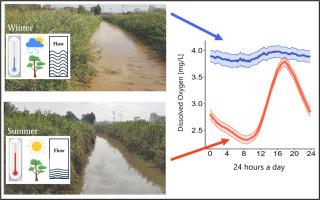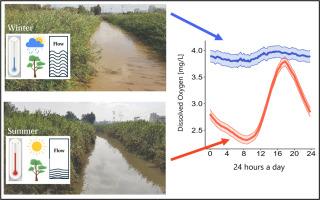地中海气候下低地城市河流中每日、季节和洪水依赖的水质动态
IF 12.4
1区 环境科学与生态学
Q1 ENGINEERING, ENVIRONMENTAL
引用次数: 0
摘要
河流的水质提供了河流生态系统功能和状态的基本信息。用传感器进行的高频测量可以揭示这些溪流中水文和生物地球化学过程的细节,这些细节很难通过其他采样方法获得。在地中海气候的河流中通常缺乏这样的测量,因此,它们的时间水质模式并不完全清楚。本研究旨在量化和描述地中海低地城市河流的日常、季节和洪水依赖的水质动态,并将其与温带气候河流的水质动态进行比较。从2019年7月开始,每隔15分钟测量以色列低地城市河流Yarkon Stream中的溶解氧、二氧化碳、硝酸盐、cDOM、叶绿素a、浊度、电导率、pH值、水位和光强度数据。研究发现,基流条件下的水质动态受污水处理厂输入和生物地球化学反应的控制,而不受排放波动的影响。此外,在基流条件下,通过日线图比通过平均季节值的比较更明显地观察到水质变化。这对溶解氧、pH值、CO2、叶绿素a和浊度尤其适用。洪水主要是稀释过程,而冲水事件只发生在特定事件中,主要是在前一次洪水之后紧接的洪水期间。从这项研究中获得的见解有望为开发低地城市地中海河流水质概念模型提供基础基础。它们还有望增强我们对低地城市地中海河流与温带气候河流的异同的理解,因为温带气候有更多的数据可用。本文章由计算机程序翻译,如有差异,请以英文原文为准。


Daily, seasonal, and flood-dependent dynamics of water quality in a lowland urban stream in a Mediterranean climate
Water quality in streams provides fundamental information on the stream’s ecosystem functioning and status. High-frequency measurements, taken with sensors, can reveal details about hydrological and biogeochemical processes in these streams, which are difficult to obtain through other sampling methods. Such measurements are generally lacking in streams in Mediterranean climates, and thus, their temporal water quality patterns are not entirely clear. This study aimed to quantify and characterize the daily, seasonal, and flood-dependent water quality dynamics in a lowland urban Mediterranean stream, and to compare them to water quality dynamics in streams located in temperate climates. Data of dissolved oxygen, carbon dioxide, nitrate, cDOM, chlorophyll a, turbidity, electrical conductivity, pH, water level, and light intensity in the Yarkon Stream, a lowland urban stream in Israel, were measured in 15-minute intervals beginning in July 2019. It was found that water quality dynamics, under baseflow conditions, were controlled by the input from wastewater treatment plants and biogeochemical reactions and not by fluctuations in discharge. In addition, water quality variability, under baseflow conditions, was more distinctly observed through diel patterns than through comparisons of average seasonal values. This was especially true for dissolved oxygen, pH, CO2, chlorophyll a, and turbidity. Floods were dominated by dilution processes, while flushing incidents occurred only during specific events, mostly during floods that followed closely after a preceding one. The insights gained from this study are expected to provide a foundational basis for developing a conceptual model of water quality in a lowland urban Mediterranean stream. They are also expected to enhance our understanding of the similarities and differences between lowland urban Mediterranean streams and those in temperate climates, for which more data are available.
求助全文
通过发布文献求助,成功后即可免费获取论文全文。
去求助
来源期刊

Water Research
环境科学-工程:环境
CiteScore
20.80
自引率
9.40%
发文量
1307
审稿时长
38 days
期刊介绍:
Water Research, along with its open access companion journal Water Research X, serves as a platform for publishing original research papers covering various aspects of the science and technology related to the anthropogenic water cycle, water quality, and its management worldwide. The audience targeted by the journal comprises biologists, chemical engineers, chemists, civil engineers, environmental engineers, limnologists, and microbiologists. The scope of the journal include:
•Treatment processes for water and wastewaters (municipal, agricultural, industrial, and on-site treatment), including resource recovery and residuals management;
•Urban hydrology including sewer systems, stormwater management, and green infrastructure;
•Drinking water treatment and distribution;
•Potable and non-potable water reuse;
•Sanitation, public health, and risk assessment;
•Anaerobic digestion, solid and hazardous waste management, including source characterization and the effects and control of leachates and gaseous emissions;
•Contaminants (chemical, microbial, anthropogenic particles such as nanoparticles or microplastics) and related water quality sensing, monitoring, fate, and assessment;
•Anthropogenic impacts on inland, tidal, coastal and urban waters, focusing on surface and ground waters, and point and non-point sources of pollution;
•Environmental restoration, linked to surface water, groundwater and groundwater remediation;
•Analysis of the interfaces between sediments and water, and between water and atmosphere, focusing specifically on anthropogenic impacts;
•Mathematical modelling, systems analysis, machine learning, and beneficial use of big data related to the anthropogenic water cycle;
•Socio-economic, policy, and regulations studies.
 求助内容:
求助内容: 应助结果提醒方式:
应助结果提醒方式:


